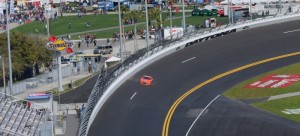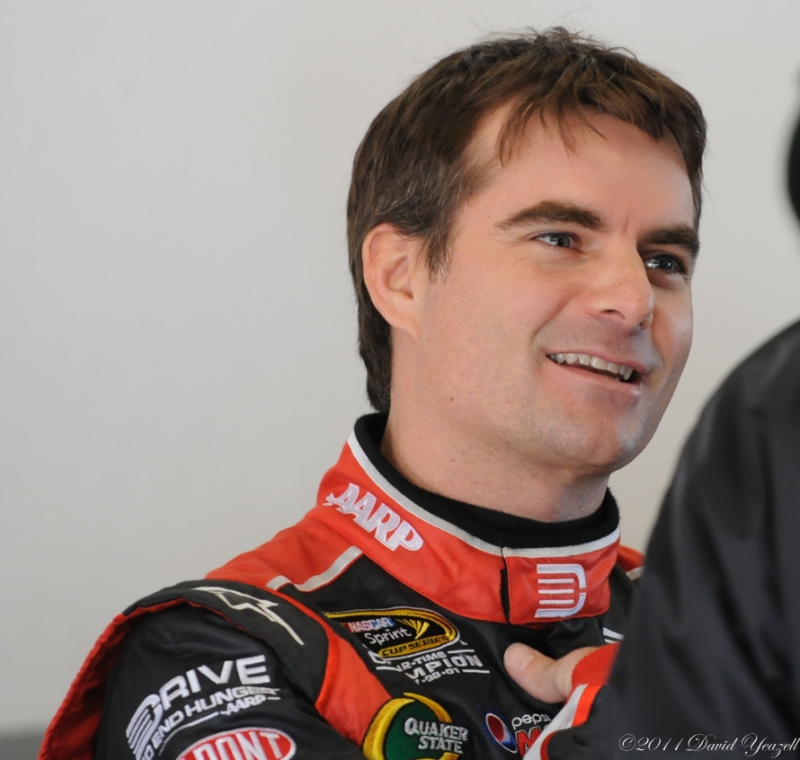When the nations economy tanked in 2008, the ticket renewals for 2009 suddenly slumped. Track operators scrambled for a way to keep the fans coming back. Some did media blitzes touting lower concession prices (usually lowered by a few pennies) and their overstated special fan activities. Needless to say, all these new fan activities were coming at higher prices. Some tracks that in the past had demanded that season ticket holders pay in advance, sometimes nearly a year in advance for their tickets, suddenly began payment plans. These plans of course, did not involve any kind of price reductions.
[media-credit name=”David Yeazell” align=”alignright” width=”300″] [/media-credit]Although ticket sales did fall in 2009, it wasn’t enough for NASCAR or the track operators to take it all that seriously. When the 2010 season arrived it was obvious by the empty seats for the Daytona 500 that the lack of response was noticed by the fans. When the series moved on to California Speedway, it was all but impossible for the TV cameras to avoid showing the thousands of empty seats. In fairness of course, the left coast track has always had a dismal attendance record. If these facts didn’t get their attention, it was in March when the series headed to Bristol Motor Speedway, a track that held the record of 55 straight sellouts for NASCAR’s top series events. The cameras panned and attempted to miss the empty seats, but it was a lost cause. The fans at home could clearly see the empty seats on the front stretch. Despite NASCAR and BMS claiming that the sellout only missed by about 22,000 seats, it was evident that the number was much higher, estimated to be 45,000 empty seats.
[/media-credit]Although ticket sales did fall in 2009, it wasn’t enough for NASCAR or the track operators to take it all that seriously. When the 2010 season arrived it was obvious by the empty seats for the Daytona 500 that the lack of response was noticed by the fans. When the series moved on to California Speedway, it was all but impossible for the TV cameras to avoid showing the thousands of empty seats. In fairness of course, the left coast track has always had a dismal attendance record. If these facts didn’t get their attention, it was in March when the series headed to Bristol Motor Speedway, a track that held the record of 55 straight sellouts for NASCAR’s top series events. The cameras panned and attempted to miss the empty seats, but it was a lost cause. The fans at home could clearly see the empty seats on the front stretch. Despite NASCAR and BMS claiming that the sellout only missed by about 22,000 seats, it was evident that the number was much higher, estimated to be 45,000 empty seats.
I did a story that week http://www.onpitroad.com/2010/03/bristol-sellout-is-no-more.html about the wake up call evolving from that race, and how BMS had made attempts to stop the bleeding. In addition to the failure of the tracks to address the situation, I made an observation that the surrounding service industry refused to make any concessions on their part. BMS has begun taking steps to address that and I will cover that in a later column.
Ten years ago NASCAR was experiencing a robust economy, it was the fastest growing fan sport in America. Ticket sales were so brisk that many of the established tracks were quickly gearing up to add more seats. The TV networks were battling each other over the right to broadcast races. NASCAR and the largest track owners, International Speedway Corporation (ISC) and Speedway Motorsports Inc. (SMI) were recording record profits. They had a product so popular folks were begging them to take their money.
Two new tracks were opened in 2001 by ISC, Chicagoland Speedway and Kansas Speedway. Not to abandon the thoughts of increased profits both tracks prohibited fans from bringing coolers into the grandstand. There was a specific prohibition against bringing any food or beverages into the grandstands. This ensured the increased sales of highly overpriced food and beverages and a guarantee to maximum profits.
The older tracks allowed the long tradition of fans being able to bring coolers into the stands and the fear that race fan protest could effect ticket sales kept those policies in place. When the Twin Towers were attacked on September 11, 2001 the whole nation reeled in shock and horror that such an attack could have happened. NASCAR quickly cancelled the race scheduled for that weekend as the government had grounded air traffic in a knee jerk reaction. That pause gave NASCAR and the track owners time to consider a more permanent response. They responded by using the fear instilled in Americans to finally take a swipe at those dreaded coolers. “In the interest of security” the tracks had developed a new marketing plan. Knowing that the fans would protest outright bans on coolers, the plan was to downsize the coolers allowed. From a 14”x14”x14” cooler allowed at most tracks, the new 6”x6”x 12” cooler rule was implemented. This size of course was not an industry standard size, but lucky for the fans, each track would have just such coolers available for sale. The new rule did draw some protest, but ISC quickly waved the American flag and proclaimed the Patriotic nature of the change.
As the policy continued over the years, most tracks continued the upward spiral of ticket and concession prices, showing no mercy on the fans. However at Kansas Speedway the expected sellouts did not occur and as ticket sales continued to lag it forced the track in 2006 to join most of the other tracks with the 6x6x12 cooler policy. Of course at Chicagoland Speedway the ban continued, although they did allow fans to bring ONE factory sealed plastic bottle of water in with them.
Back to 2011, the wake up call has finally arrived at ISC headquarters and some new changes are coming in 2011. The NORMAL size coolers are back! Yep, you read that correctly. The NEW Daytona international Speedway gate admission policy now allows the old familiar 14”x14”x14” soft sided coolers. In addition, the 18” clear plastic bag rule has made way to allow one school sized backpack. That’s a pretty good start, but I wonder if it has come too late.
OK, that takes care of Daytona, let’s see what’s happening at the other ISC tracks:
Phoenix International Raceway – Larger cooler, still 18×18 plastic bag
California Speedway- Small coolers, backpacks
Martinsville Speedway- Large cooler, backpack
Talladega Superspeedway- Large cooler-backpack
Richmond International Raceway – Large cooler, backpack
Darlington Raceway – Large cooler, 18×18 bags
Kansas Speedway – Larger cooler, backpack
Michigan International Speedway – Large cooler, backpack
Watkins Glen International – Large cooler, backpack
Chicagoland Speedway – Small cooler, no backpack
Homestead-Miami Speedway – Large cooler, backpack







Richmond has enlarged seats on the front stretch by removing seats on each row. YIPPEE! I’m small but always end up between 2 large people (1 of which is my hubby). We take a few beers and water in with us, but always did fine with the smaller cooler. Someone has to drive back to Chesterfield! I smoke (not good for a pharmacist) but don’t mind having to go out of the stands to do so, I always tried to be a courteous puffer. I think the changes are good for the fans, and look forward to being able to have a little more room come April!